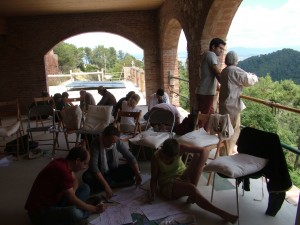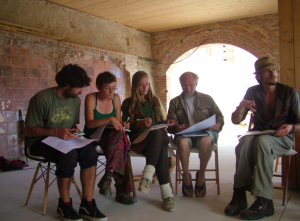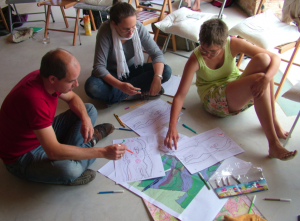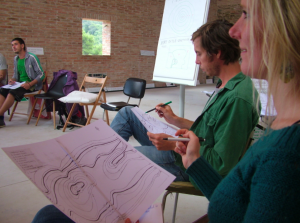“To treat life as less than a miracle is to give up on it” Thomas Berry Today we began talking about Design Methods and what to look for on a plot of land. First we look for things that affect the property from the out side, for example the water, the sun, climate, wildlife, bureaucracy, pollution… and we draw the fluxes in to a map to understand the land. We also look at the land form and the aspects to see how the sun will shine on the slope.  Then we talk about the most important element in Permaculture: Observation. It is the most important because if you make a wrong observation you will do a wrong design. After that we talked about zoning. In Permaculture we recognize 6 zones for the design, from 0 to 5. The zones are determined by how often you visit it. You live in Zone 0, its your home. You visit Zone 1 every day, this is where you will have your vegetable garden. Zone 2 is an intensive cultivated orchard with small animals like chickens. In Zone 3 you will have your commercial crops and large foraging animals like cows. In Zone 4 you have a harvest forest for timber and other things. Zone 5 will be dedicated to wild life, this zone is not cultivated. To understand all of this and put it in the map we talked about topographical maps and we did some exercises how to read contour maps.
Then we talk about the most important element in Permaculture: Observation. It is the most important because if you make a wrong observation you will do a wrong design. After that we talked about zoning. In Permaculture we recognize 6 zones for the design, from 0 to 5. The zones are determined by how often you visit it. You live in Zone 0, its your home. You visit Zone 1 every day, this is where you will have your vegetable garden. Zone 2 is an intensive cultivated orchard with small animals like chickens. In Zone 3 you will have your commercial crops and large foraging animals like cows. In Zone 4 you have a harvest forest for timber and other things. Zone 5 will be dedicated to wild life, this zone is not cultivated. To understand all of this and put it in the map we talked about topographical maps and we did some exercises how to read contour maps. 


 After lunch we began a new topic that interested everybody, is so central in Permaculture designs and is vital to ValldauraLabs, WATER. At the beginning of the afternoon we talked about strategies and how to maximize water retention in a landscape. This is important in drylands because the 70% of the fresh water that we use is dedicated to irrigation. The average person in the city is 300l/day and the FAO estimates that 45l/day is adequate to satisfy our needs. So in cities we need to think how to reduce, reuse and clean the water to use the water in the best way possible. We did calculations to find how many water we can use in relation to the rainfall, it was surprising that most of us used more water than our roofs collect.
After lunch we began a new topic that interested everybody, is so central in Permaculture designs and is vital to ValldauraLabs, WATER. At the beginning of the afternoon we talked about strategies and how to maximize water retention in a landscape. This is important in drylands because the 70% of the fresh water that we use is dedicated to irrigation. The average person in the city is 300l/day and the FAO estimates that 45l/day is adequate to satisfy our needs. So in cities we need to think how to reduce, reuse and clean the water to use the water in the best way possible. We did calculations to find how many water we can use in relation to the rainfall, it was surprising that most of us used more water than our roofs collect.  Later we talked about the eternal mantra of Permaculture: Slow, Spread, Sink and Store. All of these four are strategies to keep the water in your property. We can store the water in soil, in dams, rivers and aquifers and biomass, soil being the most important one. Trying to store water in the soil without planting trees and plants is futile. We begin by planting the hill tops with the help of swales which are designed to slow the water flow. The second think that we need to do is replanting the rivers sides to prevent soil erosion and to store more water and biomass. In hawaii they say ” If you cut the trees of the top of the mountain the goods will be angry”
Later we talked about the eternal mantra of Permaculture: Slow, Spread, Sink and Store. All of these four are strategies to keep the water in your property. We can store the water in soil, in dams, rivers and aquifers and biomass, soil being the most important one. Trying to store water in the soil without planting trees and plants is futile. We begin by planting the hill tops with the help of swales which are designed to slow the water flow. The second think that we need to do is replanting the rivers sides to prevent soil erosion and to store more water and biomass. In hawaii they say ” If you cut the trees of the top of the mountain the goods will be angry”